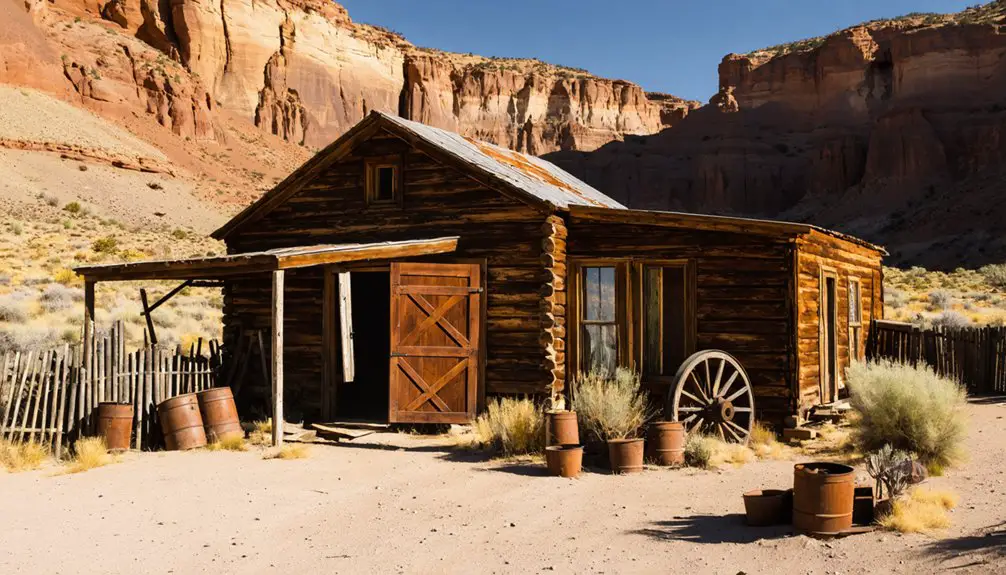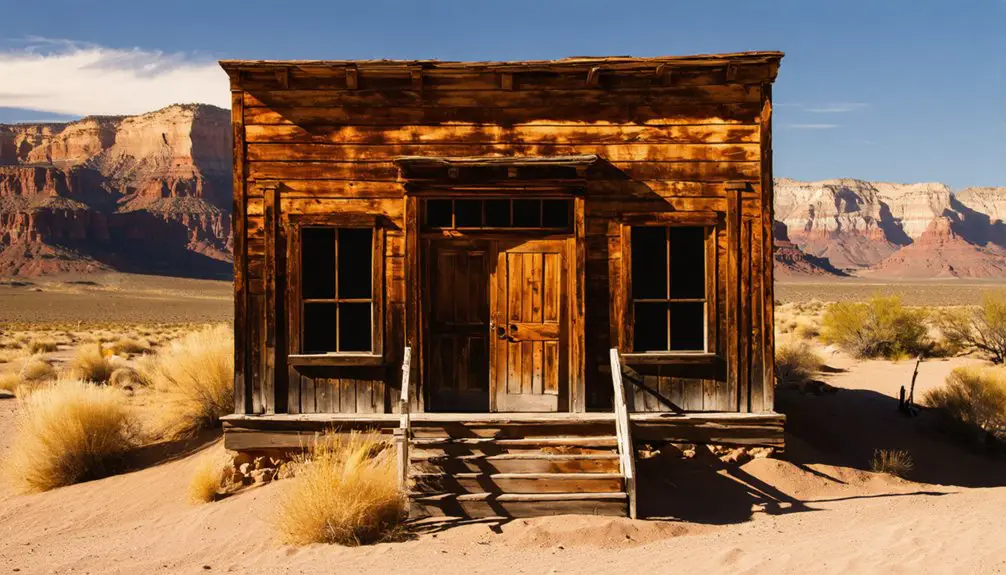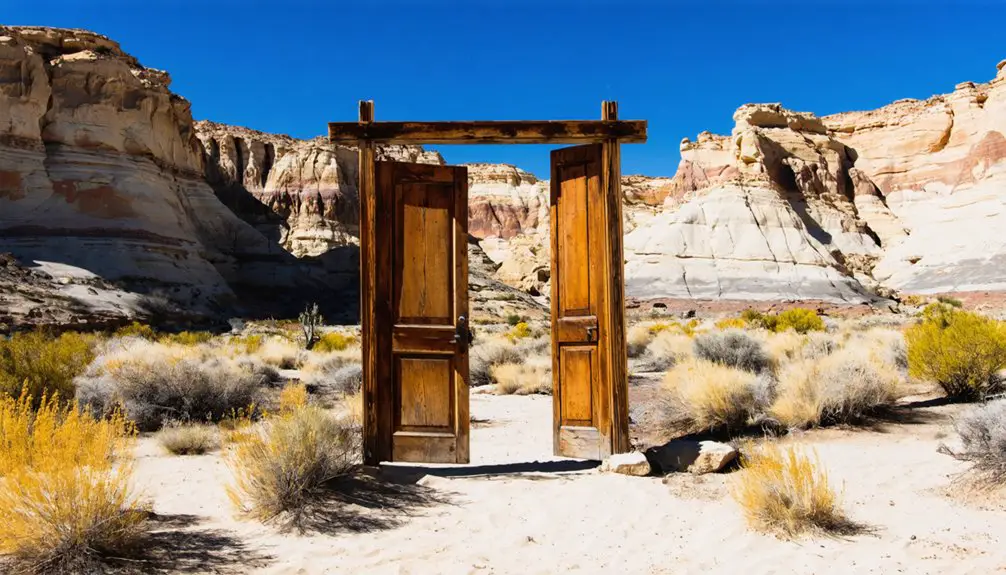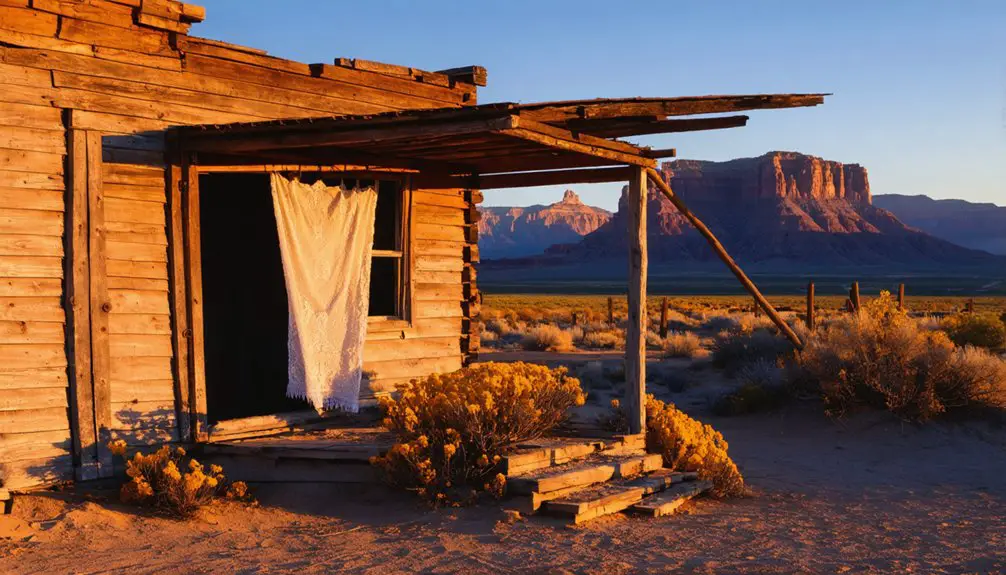You’ll find Paria ghost town along the banks of its namesake river in southern Utah, where Mormon pioneers established a settlement in 1865. Despite innovative irrigation attempts and sturdy sandstone structures, the community faced devastating floods between 1883-1888, severe droughts, and salt-laden soil that made farming nearly impossible. By 1892, most residents had abandoned their homesteads, though their legacy lives on through archaeological remains, a historic cemetery, and Hollywood western film sets. The story of Paria’s rise and fall reveals nature’s ultimate triumph over human determination.
Key Takeaways
- Paria was a Mormon pioneer settlement established in 1865 along the Paria River in southern Utah, now an abandoned ghost town.
- Severe flooding between 1883-1888, combined with drought and salt accumulation, forced most residents to abandon their homesteads by 1892.
- Remnants include sandstone structures, a cemetery with replacement tombstones, and archaeological evidence of earlier Native American settlements.
- The site became popular for Western films, featuring a movie set built in 1961 that was partially restored between 1999-2001.
- Visitors can access Paria via a 5-mile dirt road off Highway 89, with basic amenities and interpretive plaques explaining its history.
The Mormon Pioneer Settlement Years
When Mormon pioneers first ventured into the harsh desert landscape of southern Utah in 1865, they established a settlement called Rockhouse under the leadership of Peter Shirts.
After the Black Hawk War ended in 1867, you’ll find that settler numbers grew considerably, though they faced persistent challenges with irrigation as the desert soil quickly absorbed precious spring runoff.
Under Mormon leadership, the settlers attempted agricultural innovation, but security concerns from Indian raids ultimately forced them to adapt. William Meeks and his group of Mormon missionaries arrived to establish a permanent presence in the area.
The settlement was situated along the Paria River banks, which served as a vital water source for the community’s survival.
By 1870, the community split into two groups, with half the settlers moving five miles upstream to found Pahreah (later Paria).
This strategic relocation demonstrated the pioneers’ determination to maintain their foothold in the region despite the harsh realities of frontier life.
Life Along the Paria River
Along the meandering Paria River in central Kane County, Utah, early settlers discovered a landscape of striking geological contrasts, where towering sandstone walls met narrow canyons adorned with desert varnish streaks.
You’ll find that these pioneers built their cultural heritage around the river’s ecology, establishing sandstone homes, a general store, and essential community buildings by the 1870s.
Life wasn’t easy, though. The desert soil’s rapid absorption of surface runoff made irrigation challenging, while devastating spring floods between 1883 and 1888 repeatedly destroyed fields and structures. Early settler John D. Lee faced similar difficulties diverting water from the Paria for irrigation at Lonely Dell Ranch.
Harsh desert conditions tested settlers’ resilience, as porous soil and destructive floods undermined their farming efforts along the Paria.
The area’s connections remain visible today through Scenic Byway 12, which guides modern travelers through this historic region’s dramatic landscapes.
Despite these hardships, the community persisted, maintaining their settlement until 1929. The river valley’s natural features – including arches, amphitheaters, and hanging gardens – provided a dramatic backdrop for daily life in this remote desert outpost.
Natural Disasters and Environmental Struggles
If you’d visited Paria in the 1880s, you’d have witnessed the devastating annual floods from the Paria River that repeatedly destroyed fields, buildings, and essential infrastructure between 1883 and 1888.
These destructive spring floods washed away precious farmland and severely undermined the town’s agricultural foundation, ultimately forcing most residents to abandon their homesteads until only eight families remained by 1892.
Today, visitors can explore the old Paria Cemetery with its weathered headstones telling stories of the past settlers.
The extreme seasonal variations of the river valley, which could range from completely dry in summer to violently flooding in spring, left behind expansive salt plains and made sustained farming virtually impossible despite early successful crops. Even a brief gold mining operation in 1911-1912 couldn’t revive the struggling settlement’s fortunes.
Devastating Annual River Floods
During the years of Paria’s settlement, devastating floods along the Paria River posed a relentless threat to the town’s survival. The flood frequency analysis revealed a pattern of extreme events, with some of the most severe flooding occurring when heavy rainfall combined with snowmelt, as documented in December 1966. NOAA monitoring services now track these flood patterns to help protect nearby communities.
You’ll find that rainfall during these events could range from 1.05 to 12.6 inches, generating unprecedented flood magnitudes. Like the paroxysmal storms that Gilbert documented in the Southwest, these events brought sudden and intense rainfall that overwhelmed the landscape.
The environmental impact proved catastrophic for the settlement. The basin’s steep terrain and sparse vegetation accelerated runoff, while intense storms in the semi-arid climate created perfect conditions for flash floods.
These destructive waters eroded the landscape, damaged vital infrastructure, and deposited heavy sediment loads that wore away at historical sites, ultimately contributing to the town’s abandonment.
Drought and Salt Deposits
While devastating floods posed one serious threat to Paria’s survival, the town’s settlers also faced relentless cycles of drought and salt accumulation that severely undermined their agricultural efforts.
Mormon pioneers established farming settlements here despite the challenging conditions, demonstrating remarkable perseverance.
Despite attempts at drought resilience strategies, you’ll find that the Paria River Valley’s harsh desert conditions caused rapid absorption of spring runoff, leaving insufficient water for crops.
The region’s salt flat ecology revealed the environmental extremes: white crystal plains formed as floodwaters evaporated, creating an inhospitable growing environment.
You can observe how these mineral deposits covered extensive portions of the floodplain, particularly during dry spells.
The combination of drought-prone conditions and saline soil made traditional farming nearly impossible, as the desert climate’s intense heat accelerated evaporation and concentrated salt deposits that prevented crop regrowth.
These agricultural challenges, combined with the massive flooding of 1883, ultimately contributed to most residents abandoning the settlement.
The Rise and Fall of a Desert Community
Despite its promising beginnings as a Mormon pioneer settlement in 1865, Paria’s journey from establishment to abandonment spans a dramatic tale of human perseverance against harsh desert conditions.
You’ll find that the pioneer spirit drove early settlers, led by Peter Shirts, to build sturdy sandstone homes and establish essential community infrastructure including a store, church, and school.
Under William Meeks’ direction and with John D. Lee’s help constructing irrigation systems, the community initially flourished.
However, community challenges mounted as the Paria River’s unpredictable flooding ravaged farmlands between 1883 and 1888, while rapid water absorption into desert soil made irrigation nearly impossible.
Despite attempts at revitalization through gold mining in 1911, recurring floods ultimately drove residents away.
Daily Life in Early Paria

Life in early Paria revolved around the delicate balance between agricultural survival and community cohesion.
You’d find yourself starting each day tending to fields irrigated by the precious waters of the Paria River, channeled through dams and ditches built by your neighbors’ collective effort. Daily chores centered around the robust sandstone homes, like the iconic Rockhouse, where you’d store provisions from the general store to weather the harsh desert conditions.
Survival in Paria meant rising with the sun, working the irrigated fields, and storing supplies in sandstone shelters against nature’s challenges.
Community gatherings at the church and store weren’t just social occasions – they were essential lifelines in your struggle against environmental hardships.
You’d share strategies for managing crops in porous soil and rebuilding after devastating floods. While the desert’s untamed beauty surrounded you, survival meant adapting to nature’s unpredictable rhythms through tight-knit cooperation.
Archaeological Remains and Historic Sites
The archaeological remains of Paria tell a layered story stretching far beyond its Mormon settlement period.
You’ll find evidence of Ancestral Puebloans and Fremont peoples through their cliff dwellings, petroglyphs, and artifacts scattered throughout the canyon areas, highlighting the region’s rich cultural heritage.
The site’s archaeological significance extends through its Mormon pioneer era, where you can explore the weathered ruins of brick structures and root cellars that once housed 47 families.
A replica cemetery with replacement tombstones stands as a tribute to the early settlers, while remnants of early 20th-century mining equipment reveal the town’s brief gold rush period.
These preserved ruins, protected within Grand Staircase-Escalante National Monument, offer you a unique glimpse into multiple layers of human habitation along the Paria River.
Hollywood’s Love Affair With Paria

You’ll find Paria’s cinematic legacy embedded in classic Western films like “Buffalo Bill” (1944) and “Westward the Women” (1952), which utilized the ghost town‘s striking red-rock backdrop and authentic pioneer setting.
The site’s movie sets, though repeatedly challenged by natural disasters and arson, have been integral to Hollywood’s Western storytelling since the 1940s, with multiple reconstructions maintaining this cultural connection.
The dramatic landscapes of Paria continue to captivate filmmakers and audiences alike, offering a timeless visual portal into America’s frontier past through both its natural formations and carefully reconstructed movie sets.
Famous Western Film Backdrop
- A replica Old West town was built west of the original Paria ghost town for *Sergeants 3*.
- The movie set remained active until *The Outlaw Josey Wales* (1975).
- Volunteers and BLM staff restored the damaged set in 1999-2001.
- Though the set burned in 2006, you can still explore the stunning natural backdrop that captivated filmmakers.
Building Movie Set Legacy
Since Hollywood first discovered Paria’s cinematic potential in the 1940s with “Buffalo Bill,” this remarkable location has served as a cornerstone of Western filmmaking.
You’ll find its most significant development came in 1961 when a permanent movie set was constructed a mile west of the original townsite, featuring five full-shell buildings that captured the Old West’s essence.
Despite nature’s challenges, including devastating floods in 1998, the community’s dedication to film preservation has proven unwavering.
The Bureau of Land Management and local volunteers undertook extensive set restoration efforts between 1999 and 2001.
Even after a suspicious fire in 2006 destroyed the rebuilt set, Paria’s cinematic legacy endured with the construction of a new facade for “The Attic Door” in 2007, demonstrating the location’s enduring appeal to filmmakers.
Cinematic Desert Beauty Preserved
While most movie locations fade into obscurity, Paria’s distinctive bentonite hills and dramatic desert vistas have maintained their allure for filmmakers seeking authenticity in their productions.
These cinematic landscapes continue to captivate audiences through their timeless appeal, from classic Westerns to modern productions like “Westworld.”
Despite challenges in film preservation efforts, including devastating floods and fires that destroyed movie sets, Paria’s natural beauty remains unblemished.
- You’ll find vibrant, color-drenched scenery created by unique bentonite formations
- You can explore the same rugged terrain that served as backdrops for films like “Buffalo Bill” and “The Outlaw Josey Wales”
- You’ll discover dynamic environmental features, from seasonal flooding to canyon vistas
- You’re free to experience the untamed desert environment that helped shape Western cinema’s iconic look
Exploring the Ghost Town Today

Despite its remote location in the Utah desert, Paria ghost town remains accessible to modern-day visitors via a 5-mile dirt road off Highway 89 between Kanab and Page, Arizona.
Hidden in Utah’s desert expanse, Paria ghost town beckons visitors down a remote dirt road, connecting modern adventurers to its historic past.
You’ll find a day-use site with basic amenities, including picnic facilities and a drop toilet, though it’s wise to bring your own supplies.
For ghost town exploration, you can discover remnants of the 1870s Mormon settlement marked by the “Old Town Paria” rock marker.
While the movie set buildings no longer exist, the site offers rich historical context through interpretive plaques and a nearby cemetery.
The surrounding landscape provides stunning opportunities to explore colorful badlands, layered cliffs, and the Paria Rainbow Mountains.
Plan your visit during dry weather, as the dirt access road becomes treacherous when wet.
Legacy of Desert Determination
The resolute Mormon pioneers who established Paria in 1865 commenced on an ambitious venture that would test the limits of human perseverance against nature’s harsh realities.
Their pioneer resilience manifested through irrigation innovations and communal determination, even as the harsh desert environment challenged their every effort.
You’ll discover their legacy of determination through these remarkable aspects:
- John D. Lee’s sophisticated dam and irrigation system demonstrated engineering ingenuity in conquering water scarcity.
- The community’s persistence in rebuilding after devastating floods from 1883-1888 showed unwavering spirit.
- Establishment of civic institutions like the post office in 1892, even as population declined, reflected commitment to permanence.
- Their architectural adaptation to the environment through sturdy sandstone structures proved their resourcefulness in harsh conditions.
Frequently Asked Questions
What Animals and Wildlife Were Commonly Found in Historic Paria?
You’d have found rich desert fauna including mule deer, coyotes, mountain lions, bighorn sheep, red-tailed hawks, and rattlesnakes, though wildlife conservation wasn’t prioritized during early settlement periods.
Did Any Native American Artifacts Survive in the Paria Area?
You’ll find significant Native American petroglyphs carved into Paria Canyon’s walls, featuring ancient depictions of bighorn sheep and human figures. These archaeological discoveries remain accessible, though they shouldn’t be touched.
What Was the Average Temperature and Rainfall in Paria’s Peak Years?
While you’d experience scorching summer highs near 80°F, winter drops to 34°F. You’ll find temperature patterns varying dramatically, with rainfall averages peaking at 1.3 inches during July’s monsoon season.
Were There Any Famous Outlaws or Notable Incidents in Paria?
You won’t find documented outlaw legends in the historical record. The town’s notable incidents centered on natural challenges like flooding, rather than criminal activity, despite Hollywood’s later Western portrayals.
How Did Residents Get Medical Care in Early Paria?
You’d rely on home remedies, midwives, and neighboring settlers since no medical facilities existed. Healthcare challenges like remote location, floods, and harsh terrain made accessing professional doctors in distant towns extremely difficult.
References
- https://en.wikipedia.org/wiki/Paria
- https://www.onlineutah.com/pariahistory.shtml
- https://www.downthetrail.com/exploring-utah/paria-movie-set-near-kanab-utah-old-pahreah-townsite-map-directions/
- https://www.rexby.com/Meeshuno/ttd/old-west-ghost-town-adventure
- https://www.americansouthwest.net/utah/grand_staircase_escalante/paria.html
- https://kids.kiddle.co/Paria
- https://www.nps.gov/glca/learn/historyculture/leesferryhistory.htm
- http://www.azheritagewaters.nau.edu/loc_paria_river.html
- https://www.brycecanyoncountry.com/paria-valley-cannonville-tropic-henrieville/
- http://www.amwest-travel.com/awt_oldparia.html



